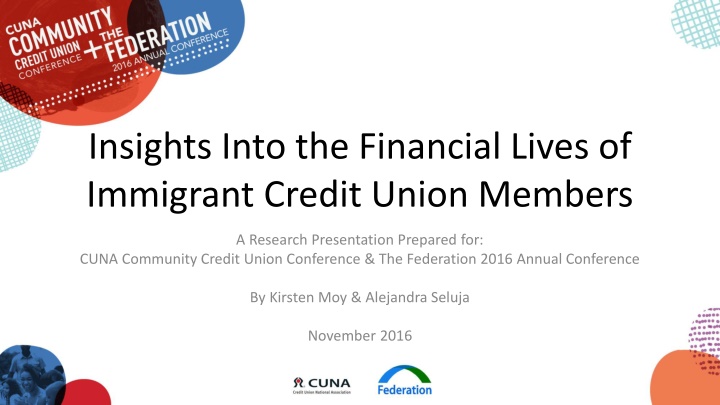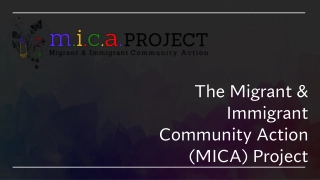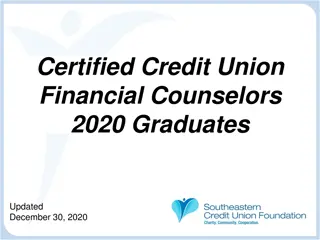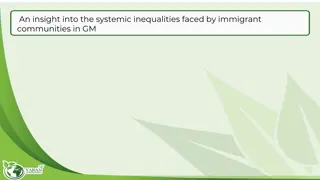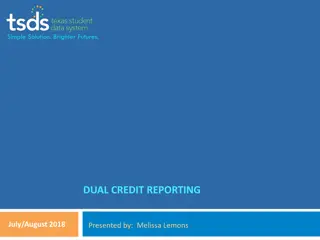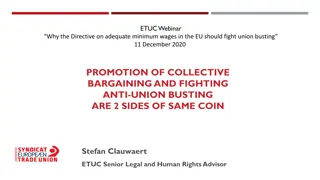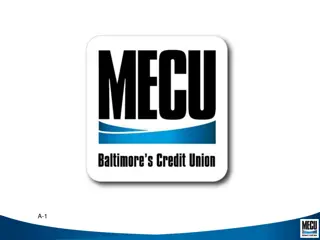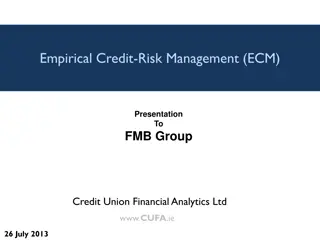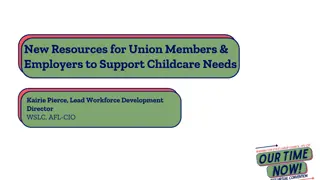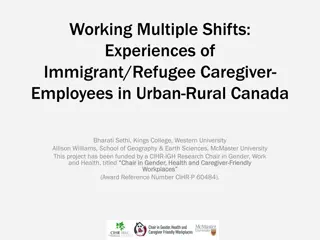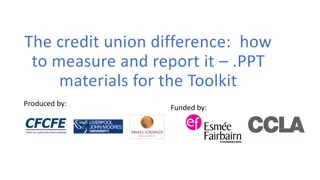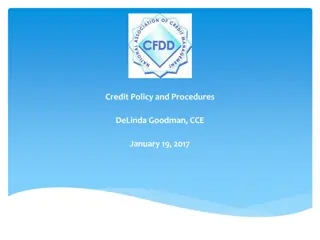Financial Insights of Immigrant Credit Union Members
Delve into the financial lives of immigrant credit union members through qualitative and quantitative research to understand their unique needs and motivations. Explore how to better reach and serve immigrant populations to enhance financial security and independence. Learn about the research methodology and diverse credit union sites involved in this study.
Download Presentation

Please find below an Image/Link to download the presentation.
The content on the website is provided AS IS for your information and personal use only. It may not be sold, licensed, or shared on other websites without obtaining consent from the author.If you encounter any issues during the download, it is possible that the publisher has removed the file from their server.
You are allowed to download the files provided on this website for personal or commercial use, subject to the condition that they are used lawfully. All files are the property of their respective owners.
The content on the website is provided AS IS for your information and personal use only. It may not be sold, licensed, or shared on other websites without obtaining consent from the author.
E N D
Presentation Transcript
Insights Into the Financial Lives of Immigrant Credit Union Members A Research Presentation Prepared for: CUNA Community Credit Union Conference & The Federation 2016 Annual Conference By Kirsten Moy & Alejandra Seluja November 2016
A Note on The Research This research has both qualitative and quantitative elements. The findings from the qualitative aspects of the research, i.e., the in-depth interviews, are not meant to be projected but rather are designed to offer insights and hypotheses.
Overview of the Presentation Introduction Understanding the Immigrant Experience Initiating and Developing a Trusted Relationship ( Acquisition ) Successfully Generating Uptake ( Cross-selling ) Deepening Engagement ( Retention ) Conclusion
Background and Rationale for the Research To better understand how to reach immigrant populations, particularly those communities with high concentrations of unbanked and underbanked consumers To identify the right combination of products, services, relationships and channels that help immigrant consumers use financial institutions to build greater financial security and independence. To address a significant information gap among financial service providers about the unique needs and motivations of immigrant consumers.
Overview of Research Methodology Partnered with 7 credit unions in 7 geographic locations Data Pulls of from 6 credit unions on member utilization of products and services 400 + Surveys using online survey software (SurveyGizmo) 30 + In-depth Interviews of members; 9 In-depth Interview of staff Surveys and interviews in three languages; immigrants from 25 countries
Diversity of Credit Union Sites Location in different regions and a mix of urban and rural A range of asset sizes: Family, the smallest at $8.2 million in assets, to Self-Help at $600+ million in assets Differences in history of serving immigrants: Family began in 1984; Rio Grande in the 2013-14 timeframe Family FCU has merged into Self-Help FCU
Demographics of Members Surveyed & Interviewed All were non-US born members: mix of refugees, citizens, permanent residents and undocumented Of those surveyed and/or interviewed: Latino (82%), Asian (11%) with mix of White, Black and Multiracial Countries with largest number surveyed: Mexico, Vietnam, Dominican Republic, Philippines 76% have been in the US 10 years or more Over 61% have children under 18 living with them and 61% support people who do not currently live with them (is US or other countries) 66.2% have a high school degree/equivalent or less 48% Did not speak English 63% Were working full time 42% said they were struggling day-to-day or would be in trouble in case of an emergency vs 58% who feel their situation is stable and are able to plan for the future
UNDERSTANDING THE IMMIGRANT EXPERIENCE
Most Moved to the US for Better Opportunities Economic (for themselves and to send money home), political (distress in their country), and social (family already here or moved later) But encountered significant challenges moving to the US Lack of documentation, language, cost of living, changes in employment, housing, transportation, cultural and lifestyle changes Lack of awareness and understanding about financial services when they first arrived Over time, raising a family changes plans to return home
Initially, a Cash Culture and Debt as Drugs Live Simply Using Cash Sense of control: Keep cash on hand at all times Cash checks immediately Cash is the way to pay for things, even big purchases Save and then buy Need a place to cash checks and need a way to send money Debt is Viewed Negatively Debt = a drug (Do not get into debt) Many don t believe anyone will lend to them Changes occur when immigrants begin to understand that building credit is a positive thing
Houses & Cars Often Bought with Cash Majority owned a car and a home or mobile home Cars are primary means of transportation as transportation systems in these cities were inadequate Cars provide opportunities to work and live Many members saved up money and bought a car or a home with cash This can delay a purchase and put a lot of stress on a family How did you pay for your car? How did you get the down payment for your home?
And, did you take a mortgage or loan to buy your home? Yes 48.60% 51.40% No Total Respondents = 173
INITIATING AND DEVELOPING A TRUSTED RELATIONSHIP ( ACQUISITION )
Initially, Little Awareness of a Credit Union Credit Union/ Bank? El Banco? Many immigrants were not aware of a CU or what they offered Went to banks because they were visible, friends/ family/coworkers had accounts there. Their paycheck was drawn from that bank, so it was the obvious choice.
Experience with Banks & Use of Alternative Financial Services From interviews, members shared that they had a bank account before a CU account because they didn t know about the credit union and were more familiar with banks Negative experiences due to lack of understanding or orientation to bank products (overdraft, fees, high interest rates) and banks provided few opportunities (many rejected for loans) Despite having CU account, why do some members keep their bank accounts open? Protection , wider availability, ready access to cash, convenience to direct deposit and bill pay Other than the Credit Union, where else do you conduct your financial business?
Transitioning to Credit Union Membership What was your main motivation when you decided to go into the Credit Union? However, some did close account after realizing benefits of CU Importantly, those who had CU account first, were less likely to open a bank account Many members said they would have loved to have known about the credit union opportunities, especially loans, before they shopped elsewhere. 11.05%, Other 8.60%, Financial Emergency/ Finances a Mess 38.30%, Place I Could Trust/Build A Relationship 8.80%, Needed A Direct Deposit for a Job 10.60%, Specific Financial Goal 22.60%, Build or Rebuild My Credit Total Respondents = 407
Entry into Credit Union Membership Word of mouth was primary motivator to join CU most go to CU because a trusted friend or family member recommends or they are referred by a trusted community partner, or church. Key Entry Points: Products: Services: Accounts to Cash Checks Car Loans Home Loans To Build/Rebuild Credit Remittances (if available) Explanation of fee structure Acceptance of alternative forms of identification
SUCCESSFULLY GENERATING UPTAKE ( CROSS-SELLING )
Many Use Credit Union Services How often do you go into the Credit Union for some kind of service? Do you use any of these services at the Credit Union?
But many members, even long-term members, are not aware of the full range of credit union s products and how the CU can help them. After you signed up with the Credit Union, and opened your Savings or Checking Account, did you get any other accounts, cards, loans, with the Credit Union? 39.20% Yes No 60.80%
What is the main reason you have not used any other accounts or products at the Credit Union? 21.90%, Other 57.10%, Don t Know What Else CU Offers/Don t Think They Qualify/Nobody Has Explained What the CU Offers 6.83%, I Didn t Need Any Other Products or Services 4.70%, The CU Doesn t Have What I Need 13.30%, Already Have Other Accounts/Products Elsewhere and Don t Want to Switch
Fear and Consequences Around Credit Hesitant and fearful to seek credits Immigrants don t understand at first that they need to build credit to create financial standing Some felt they learned it too late Believed no one will give immigrants credit If they sought credit and were denied, many retreat They can feel embarrassment, personal rejection, fear Many immigrants will not reach out again after being rejected only once This is especially true if there is no explanation for denial or pathway to acceptance CU Member Since 98: We applied in 2008, in several places and here as well, because we wanted to buy a house but we did not qualify because we didn t have a SSN. We qualified by income but we didn t due to lack of a SSN. Interviewer: And after that you never tried again? CU Member: No
DEEPENING ENGAGEMENT: WHAT MAKES MEMBERS STAY WITH THE CREDIT UNION
High Tenure & Satisfaction with the Credit Union 90% say they are satisfied or very satisfied with their credit union On a 1-5 scale, members overwhelmingly rated their credit union 5 s on treating them with respect, understanding their culture and language, and their trust of the credit union Over 80% have recommended their CU to friends and family Membership Tenure at CU Years with CU Percentage New Members 16% 1-5 Years 46% 5-10 Years 15% 10 or More Years 23%
Credit Union & Improvement in Financial Situation 78% report that their credit union has helped to improve their financial situation in one or more ways. Of this number: 56% say they are managing their money better 43% say they now save 39% say they have credit 24% feel they understand more about finances 22% feel they have a plan 12% say they don t live day to day anymore 25% now own a car 12% now own a home
Engagement Is Created Through Trusted Relationships Relationship and connection are the biggest factors in retention: Personalized, people know the customer, greater attention, not just a number Speaks my language Also understands my culture Understands the financial life of immigrants This results in positive feelings: Reduces fear, creates a sense of comfort, builds trust While members may have first learned about obtaining credit through community partners and word of mouth, tellers played a fundamental role when talking to members about how to start or rebuild credit. At other banks as they don t know us, they wouldn t give us the chance, but they did here. I can call her and she answers immediately, she knows my financial life, so the service they provide to me is much better. You are my family.
Engagement is Created Through Opportunities Creating awareness about all products and services also creates a sense of gratitude and a long-lasting connection Very thankful to CU for giving them a chance Less restrictions to getting loans without a SSN Less paperwork for other products Don t need a lot of money to keep an account Immigrants want to get information easily, without a lot of scrutiny Offering clear guidance and steps pathways -- to achieving goals results in a better life and loyalty to the CU. Helping establish credit without making it an overwhelming task offers members a big opportunity. They are a little bit more accessible, not with so many restrictions like the other banks. I like it better here because at other institutions you have to have money to keep the account open or things like that and here you can keep it opened with little money or you can even get a loan. There is no other place where they will give you opportunity for undocumented Hispanics to have your own home or your own car.
Engagement Generates Positive Word of Mouth As immigrants become more engaged in the CU, they are more likely to talk about it to other members of their community. Engagement gives them greater opportunities; others in the community see this and it creates greater discussion and word of mouth. I tell them [other people in the community] I like the credit union because it has a lot of benefits and it seems to me better than other banks. I am the person that spreads out the advertisement. My mom is here, my brother is here, all my children are here as members, and I always tell my co-workers
Our Successes We have the trust of our members We've helped them improve their financial lives in many ways We try to be there when they have crises and emergencies We've given them options to check cashers and payday and other predatory lenders and helped wean them away
Our Challenges We need to shift to a culture where everyone that "touches" a member (e.g., front line tellers) believes they have a responsibility to offer financial guidance or a referral to a financial counselor when they see a member that needs it; We need to actively communicate and offer products and services to members who need them, not passively provide access and hope that if we build it they will come.
Our Challenges We need to help create financial roadmaps and pathways for members: e.g., how to build their credit, how they get from a no to a yes on a loan application, what is the process for buying a car or a home and how can the credit union help While we don't need new products, we do need to deliver and underwrite them in different ways: e.g., goes without saying we have to offer ITIN loans, we probably have to consider using alternative credit (and not just rent or utility payments) in our underwriting, and take a little more (apparent) risk in the interest of building trust, relationships, and our portfolios
Our Opportunities If you successfully bank an immigrant member, you will often end up banking their family and friends. When you give someone an opportunity/take a chance with them when all other doors are closed, it builds incredible loyalty, sometimes for life. Immigrants represent a new demographic, not just in terms of ethnicity but in terms of age and family size, and thus in new demand for financial products and services; many immigrants are in the prime years for starting and raising families; most need cars and virtually all want to buy homes.
Thank You! This research would not have been possible without the generous support of the Ford Foundation; the participation of the credit union staff and members of Family FCU, Guadalupe CU, Holy Rosary CU, Lower Valley CU, Neighborhood Trust FCU, Rio Grande CU, and Self- Help FCU, who gave their time, their hard work and their perspectives; Joy Silha of Silha Associates who helped guide us in the research design and execution; and to the members of our invaluable support team, Vernice Arahan and Kartik Amarnath. We thank them all!
For More Information Kirsten Moy, Research Director | kmoyaspensf@gmail.com Alejandra Seluja, Field Researcher | aseluja@cubreakthrough.com National Federation of Community Development Credit Unions 39 Broadway, Suite 2140 New York, NY 10006 www.cdcu.coop
